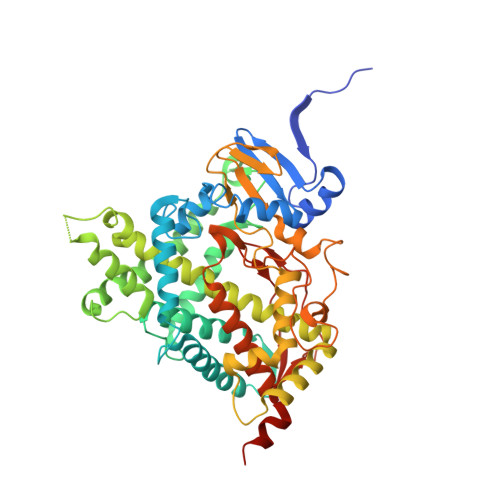Structural and Functional Evaluation of Clinically Relevant Inhibitors of Steroidogenic Cytochrome P450 17A1.
Petrunak, E.M., Rogers, S.A., Aube, J., Scott, E.E.(2017) Drug Metab Dispos 45: 635-645
- PubMed: 28373265
- DOI: https://doi.org/10.1124/dmd.117.075317
- Primary Citation of Related Structures:
5IRQ, 5IRV - PubMed Abstract:
Human steroidogenic cytochrome P450 17A1 (CYP17A1) is a bifunctional enzyme that performs both hydroxylation and lyase reactions, with the latter required to generate androgens that fuel prostate cancer proliferation. The steroid abiraterone, the active form of the only CYP17A1 inhibitor approved by the Food and Drug Administration, binds the catalytic heme iron, nonselectively impeding both reactions and ultimately causing undesirable corticosteroid imbalance. Some nonsteroidal inhibitors reportedly inhibit the lyase reaction more than the preceding hydroxylase reaction, which would be clinically advantageous, but the mechanism is not understood. Thus, the nonsteroidal inhibitors seviteronel and orteronel and the steroidal inhibitors abiraterone and galeterone were compared with respect to their binding modes and hydroxylase versus lyase inhibition. Binding studies and X-ray structures of CYP17A1 with nonsteroidal inhibitors reveal coordination to the heme iron like the steroidal inhibitors. ( S )-seviteronel binds similarly to both observed CYP17A1 conformations. However, ( S )-orteronel and ( R )-orteronel bind to distinct CYP17A1 conformations that differ in a region implicated in ligand entry/exit and the presence of a peripheral ligand. To reconcile these binding modes with enzyme function, side-by-side enzymatic analysis was undertaken and revealed that neither the nonsteroidal seviteronel nor the ( S )-orteronel inhibitors demonstrated significant lyase selectivity, but the less potent ( R )-orteronel was 8- to 11-fold selective for lyase inhibition. While active-site iron coordination is consistent with competitive inhibition, conformational selection for binding of some inhibitors and the differential presence of a peripheral ligand molecule suggest the possibility of CYP17A1 functional modulation by features outside the active site.
Organizational Affiliation:
Department of Medicinal Chemistry, University of Kansas, Lawrence, Kansas.
















